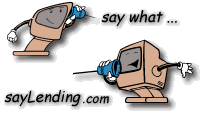 |
||||||||||||||||||||||||||||||||||||||
Other Type Mortgages:Advantages and Disadvantages |
||||||||||||||||||||||||||||||||||||||
Other Type Mortgages:Balloon Mortgages |
||||||||||||||||||||||||||||||||||||||
Many lenders offer 3- and 5- and 7-year balloon periods with attractive low interest rates.
When you balance comes due,
Advantages / Disadvantages:
|
||||||||||||||||||||||||||||||||||||||
Other Type Mortgages:Zero Down Mortgage Loans |
||||||||||||||||||||||||||||||||||||||
The Zero Down Payment Mortgage allows the donor to deposit the cash gift
The zero-down mortgage may vary from fixed-rate and ARMs.
Advantages / Disadvantages:
|
||||||||||||||||||||||||||||||||||||||
Other Type Mortgages:Buydowns and GRMs |
||||||||||||||||||||||||||||||||||||||
Buydown Mortgages
A common buydown product is the 2-1 buydown:
Graduated Payment Mortgages (GRMs):
|
||||||||||||||||||||||||||||||||||||||
Other Type Mortgages:Pledge Assets |
||||||||||||||||||||||||||||||||||||||
Referred to as asset-backed mortgages:
Generally, pledged assets are maintained in a collateral account maintained by the lender.
Homeowners should calculate the investment difference
|
||||||||||||||||||||||||||||||||||||||
|
||||||||||||||||||||||||||||||||||||||
 |